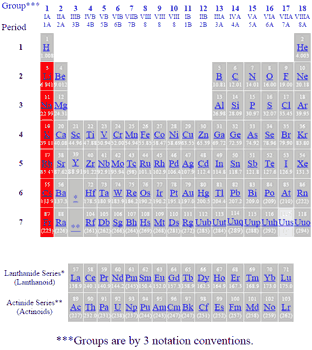
Potassium
| Element | Potassium |
| Symbol | K |
| Atomic Number | 19 |
| Molar Mass | 39.1 gmol-1 |
| Electron Configuration | [Ar]4s1 |
| Normal State | solid metal |
| Density @STP | 0.86 g cm-3 |
| Melting Point | 63oC |
| Boiling Point | 759oC |
| Stable Isotopes | 39K, 40K, 41K |
| Atomic Radius | 235 pm |
| Ionic Radius | 138 (1+) pm |
| Electronegativity (Pauling) | 0.82 |
| Ionization Energy (1st) | 419 kJ mol-1 |
| Ionization Energy (2nd) | 3051 kJ mol-1 |
| Ionization Energy (3rd) | 4411 kJ mol-1 |
| Molar Heat Capacity | 29.6 J K-1mol-1 |
| Standard Molar Entropy | 64.7 J K-1mol-1 |
| Enthalpy of Fusion | 2.4 kJ mol-1 |
| Enthalpy of Vapourization | 77.53 kJ mol-1 |
[Back to Periodic table]
- Potassium is a silvery grey soft highly reactive alkali metal element
- Potassium discovered and first isolated by Humphry Davy (1807)
- Potassium was first isolated from potash, the ashes of plants, from which its name derives
- Potassium in nature occurs only in ionic salts
- Potassium oxidizes rapidly in air and reacts vigorously with water, generating sufficient heat to ignite hydrogen emitted in the reaction
- Potassium has three natural isotopes, 40K is radioactive and is the most common radioisotope in the human body
- Agricultural fertilizers containing potassium, accounting for most of potassium chemical production
- Potassium is the second least dense metal after lithium
- Potassium is a soft solid with a low melting point, and can be easily cut with a knife
- Freshly cut potassium is silvery in appearance, but it begins to tarnish toward gray immediately on exposure to air
- In a flame test, potassium and its compounds emit a lilac colour
- Potassium hydroxide KOH is a strong base used to control pH and to manufacture potassium salts. It is also used to saponify fats and oils in industrial cleaners
- Potassium nitrate (KNO3) or saltpeter is the oxidant in gunpowder and an important agricultural fertilizer
- Potassium cyanide (KCN) is used industrially to dissolve copper and precious metals
- Potassium carbonate (K2CO3 or potash) is used in the manufacture of glass, soap, color TV tubes, fluorescent lamps, textile dyes and pigments
- Potassium permanganate (KMnO4) is an oxidizing, bleaching and purification substance and is used for production of saccharin
- Potassium chlorate (KClO3) is added to matches and explosives
- Potassium bromide (KBr) was formerly used as a sedative and in photography
- Potassium chromate (K2CrO4) is used in inks, dyes, stains (bright yellowish-red color), explosives, fireworks, tanning of leather
- Potassium superoxide, KO2 an orange solid that acts as a portable source of oxygen and a carbon dioxide absorber.
- Potassium ions are vital for the functioning of all living cells


Telephone: +44 (0)1252 405186
Email: tsc@gordonengland.co.uk
Site Links
Introducing
Nature of Thermal Spray Coatings
Surface Engineering in a Nutshell
Surface Engineering Forum
Thermal Spray Gun Repair Service
Plasma Consumable Parts
Thermal Spray Powder Supplies
Applications:
Thermal Spray Coatings on Carbon and Glass Fibre Reinforced Polymers
HVOF Coating of Paper Making Roll
Abradable Coatings
Photomicrographs
Thermal Spray Processes:
Combustion Wire Thermal Spray Process
Combustion Powder Thermal Spray Process
Arc Wire Thermal Spray Process
Plasma Thermal Spray Process
HVOF Thermal Spray Process
HVAF Thermal Spray Process
Detonation Thermal Spray Process
Plasma Flame Theory
Cold Spray Coating Process
Wear and Use of Thermal Spray Coatings
Corrosion and Use of Thermal Spray Coatings
Glossary of Thermal Spray and Surface Engineering Terms
Image Directory for Thermal Spray Coatings
Plasma Gas Flow Information
Plasma Gas Flow Correction Calculator
Contact Form
Links to other interesting sites related to thermal spray and surface engineering
Reciprocal Links
Periodic Table of the Elements
SI Units
Calculators for Conversion between Units of Measurement
Hardness Testing
Surface Engineering Message Board Archive
Surface Engineering Message Board Archive Index
Photography Gallery2
Photography Gallery3
© Copyright Gordon England




